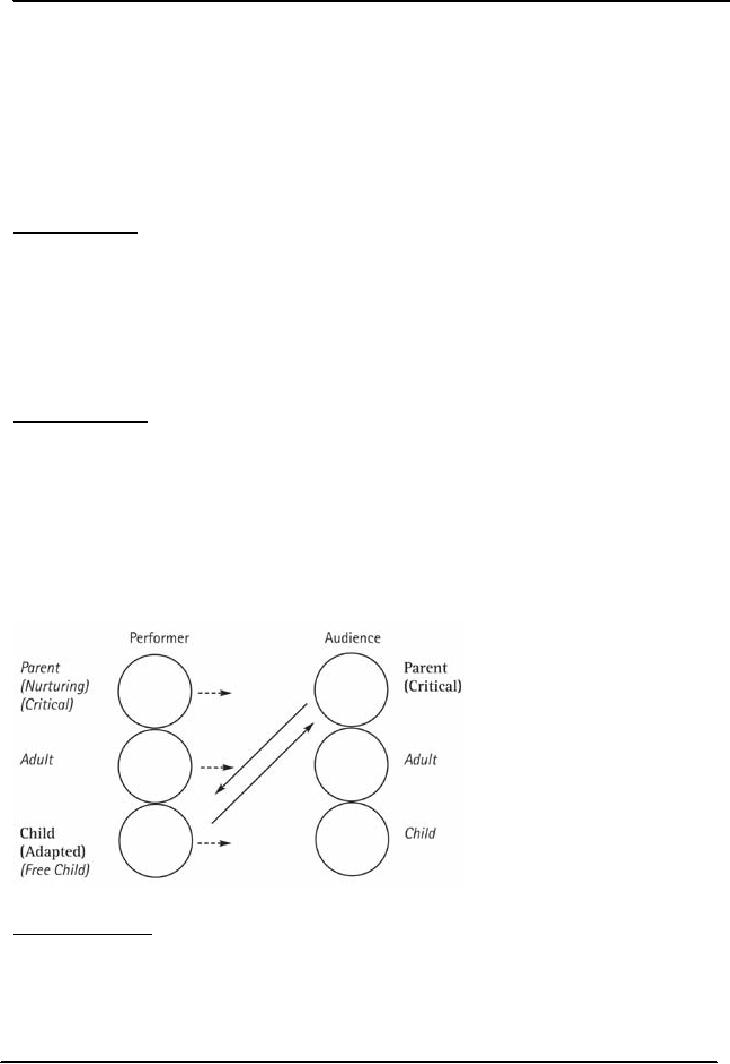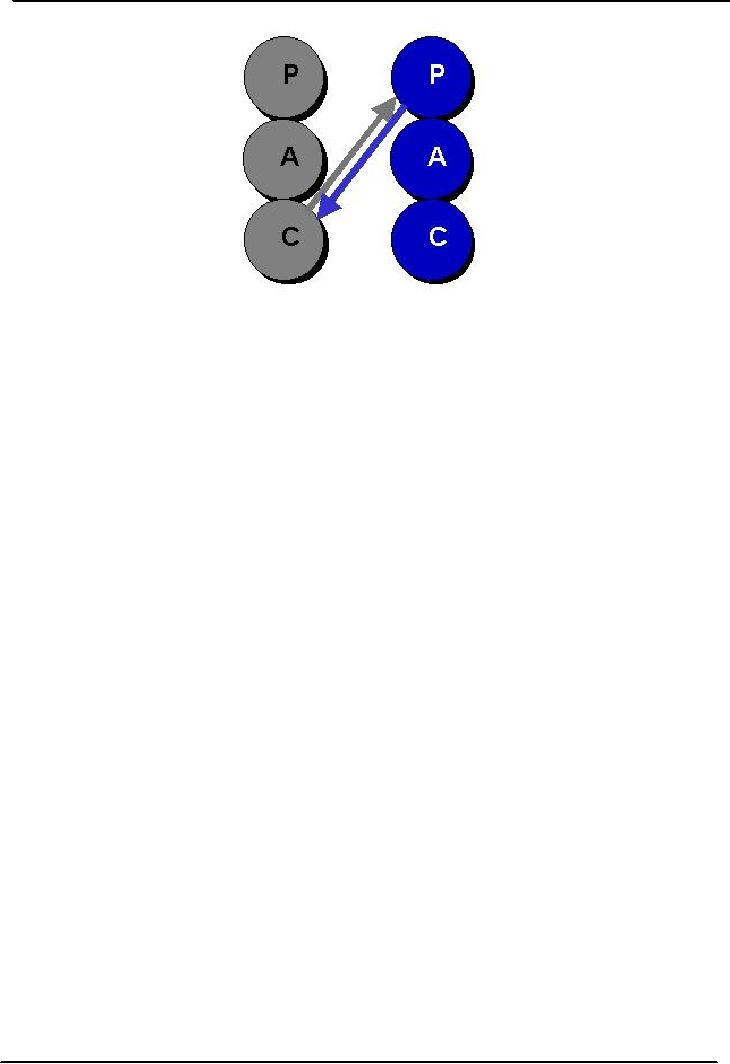 |

Theory
and Practice of Counseling -
PSY632
VU
LESSON
34
TRANSACTIONAL
ANALYSIS
Transactional
Analysis (TA), another major cognitive
theory was formulated by
Eric Berne in the
early
1960s.
The theory rose to prominence after the
publication of two best-selling
books:
o
Berne's
Games People Play (1964).
o
Thomas
Harris's I'm OK You're OK (1947).
Eric
Berne
Eric
Berne was born in 1910 in
Montreal, Canada, where his
father was a doctor and
his mother was a
writer
and an editor. Berne was
five years older than
his only sibling, a sister. He
was close to his
father,
who
died at the age of 38 when Eric was 9
years old. Berne followed in
his father's footsteps, earning
a
medical
degree from McGill
University in 1935. He then
completed a psychiatric residency at
Yale, set
up
a private practice in Connecticut and
New York, became a U.S.
citizen, and married. During
World
War
II, he served as an army psychiatrist in
Utah, where he started practicing
group therapy.
After
the war, Berne settled in Camel,
California, where he separated
from his wife and
completed his
first
book, The
Mind in Action (1947),
a critical survey of psychiatry and
psychoanalysis. In California, he
resumed
the psychoanalytic training he had
started before the war. Part of that
training was his
analysis
which
was supervised by Eric
Erickson.
In
1956, Berne was turned
down for membership in the
psychoanalytic Institute. This rejection
proved
to
be a turning point in his
life. He reacted by disassociating
himself from psychoanalysis and
devoting
his
time to the development of the transactional analysis
which has a psychoanalytic
favor.
Formulation
of TA (Dusay, 1977)
Dusay
(1977) describes the formulation of TA in
four phases:
�
In
the first phase (1955-1962),
Berne developed the concept of ego
states. His ideas
were
influenced
by his clients' descriptions of behaving
as a child, a parent, and an
adult (the three ego
status).
�
In
the second phase (1962-1966) he
concentrated on ideas about transactions
and games. Berne
published
the popular Games
People Play.
�
In
the third phase (1966-1970), he
emphasized the reasons some
individuals choose to play
certain
games
in life.
�
In
the fourth phase (from 1970
onward), he and his followers
emphasized action and
energy
distribution.
View
of Human Nature
Transactional
Analysis is an optimistic theory.
Its basic assumption is that
people can change despite
any
unfortunate
events of the past. TA is also
anti-deterministic, believing that people
have choices in their
lives:
that what was decided can be
redecided at a later date.
TA
focuses on four major methods of
understanding and predicting human
behavior:
�
Structured
analysis: Understanding what is happening within the
individual.
�
Transactional
analysis: describing what happens
between two or more
people.
143

Theory
and Practice of Counseling -
PSY632
VU
�
Game
analysis: understanding transactions
between individuals that
lead to bad feelings.
�
Script
analysis: understanding the life plan
that an individual is
following:
Structured
analysis:
Ego
States: An ego state is a
consistent pattern of feeling and
experience directly related to a
corresponding
consistent
pattern of behavior. Each person is
considered to have three
functional ego states:
child, parent,
and
adult.
The
child ego state:
The
child ego state is the first
to develop. It is that part of the personality
characterized by childlike
behaviors
and feelings. The child
ego state consists of two
subdivisions:
�
The
natural (free) child is the
part of the person that is
spontaneous, impulsive, feeling oriented
and
often
self-centered and pleasure
loving.
�
The
adaptive child is the
compliant part of the personality that
confirms to the wishes and demands
of
parental
figures.
The
parent ego state:
The
parent ego state incorporates the
attitudes and behaviors (the don'ts,
shoulds, and oughts) of
parental
figures.
Outwardly, these messages
are delivered through prejudice,
criticism, and nurturing
behavior. This
ego
state consists of two
subdivisions:
�
The
nurturing parent is the
part of the person that comforts,
praises, and aids
others.
�
The
critical parent: is
that part of the person that
finds fault, displays
prejudices, disapproves,
and
prevents
others from feelings good
about themselves.
The
adult ego state:
The
adult ego state is not
subdivided or related to a person's age.
It is the objective, thinking,
data-gathering
part
of the person. The adult ego
state tests reality, much as
the ego does in Freud's
system.
144

Theory
and Practice of Counseling -
PSY632
VU
Transactional
Analysis:
Egogram
One
way of assessing the ego
state(s) a person most
employs is through the use of
egogram. An egogram
will
remain "fixed" unless
individual decides to invest energy in
using another ego
state.
Transactions
may occur on one of three
levels:
Complementary
transaction
�
In
a complementary transaction, both
persons are operating either from the
same ego state
(for
example,
child to child; adult to adult) or
from complementary ego
states (parent to child; adult
to
parent).
Responses are predictable and
appropriate.
Examples:
An
adult to adult transaction
might look like
this:
Person
1: What time is it?
Person
II: It is 7 o'clock
�
A
child to-child transaction
would involve more
playfulness:
Person
I: let's go play with Shoib
Person
II: Yes, We could have lots of fun
with him!
�
A
parent to parent
transaction, however, would be more
nurturing or critical
Person
I: You never do anything
right
Person
II: that's because you're always
finding fault with my
work
145

Theory
and Practice of Counseling -
PSY632
VU
Crossed
Transactions
�
In
crossed transactions, an inappropriate
ego state is activated,
producing an unexpected
response.
Crossed
Transactions hurt.
An
ulterior transaction
�
An
ulterior transaction is one in
which two ego states
operate simultaneously and
one message
disguises
the other.
Person
I: can you help me'
carry these bags? They must
weigh.
Person
II: Those bags weigh approximately
twenty pounds, and you
are capable of carrying
them.
Game
Analysis
�
Games
are ulteriorly motivated
transactions that appear
complementary on the surface but
end in
bad
feelings. Games keep people
safe from exposing their
thoughts and feelings.
�
There
are first-degree, second-degree,
and third-degree games; and
all have predictable
ends.
First-degree
games are played in social
circles with anyone who is
willing to participate.
o
A
second-degree game occur
when the players go after bigger
stakes, usually in
more
o
intimate
circles, and end up with
bad feelings.
A
third-degree game usually involves tissue
damage; and the players end
up in jail, the
o
hospital,
or the morgue.
�
Individuals
playing games operate from
one of 3 positions: Victim, Persecutor,
& rescuer. To keep
games
going there is often a switch-off
where people assume new
roles.
�
In
the long run, however, game
players are losers because
they avoid meaningful and healthy
human
interactions.
Script
Analysis
Life
scripts are based on interpretations of
external events and determine
how one interacts with
others.
�
Permissions
and
injunctions
refer to positive
and negative messages to a
child. Positive messages
(Permissions) do
not limit people in any way
but negative (injunctions)
may
become destructive
scripts,
unless
a person makes conscious
efforts to overcome them.
Many parental injunctions
refers to
don'ts,
shoulds, ought not,
etc.
146

Theory
and Practice of Counseling -
PSY632
VU
Role
of the Counselor
�
TA
treatment assigns the counselor the
initial role of being a teacher. He or
she must explain to the
client
the language and concepts of
TA, a new way of thinking
about self.
�
After
this is accomplished, the counselor
contracts with the client
for specific changes and
helps
the
person achieve them.
�
Diagnosis
based on DSM-IV categories is
not stressed.
Goals
�
Primary
goals of TA focus on helping
clients transform themselves from
"frogs" into "princes
and
princesses".
�
It
is not enough that persons
learn to adjust, as in psychoanalysis.
Instead, the emphasis is on
attaining
health and autonomy.
�
Counselors
help their clients identify
and restore distorted or damaged
ego states.
�
A
major emphasis of TA is on learning about the
self in order to decide who
one wishes to
become.
Techniques
�
Treatment
contract: a
specific, concrete contract that
emphasizes agreed upon responsibilities
for both
counselors
and clients.
�
Interrogation:
speaking
to a client's adult state
until the counselor receives an
adult response.
�
Explanation:
occurs
on an adult-to-adult ego state level.
The counselor teaches the
client about some
aspects
of TA.
�
Illustration:
Enlightens the
client or elaborates a
point.
�
Confirmation:
Used
when previously modified behavior occurs
again and the counselor
points this
out
to the client.
�
Interpretation:
involves
the counselor's explanation to the child
ego state of the client the
reasons for
the
client's behavior.
�
Crystallization:
Consists
of an adult-to-adult transaction in which
the client comes to an
awareness
that
individual game playing may be given up
if so desired.
�
Confrontation:
involves the
counselor's pointing out
inconsistencies in the client's behavior
or
speech.
�
Almost
all the techniques in TA involve
some combination of questioning
confrontation and
dialogue.
The following are among the
questions most frequently
asked by TA counselors.
What
are the nicest and worst things
your parents ever said to
you?
o
What
is your earliest
memory?
o
What
is the family story about your
birth?
o
What
is your favorite fairy tale,
story, or songs?
o
How
would you describe your
mother and father?
o
How
long do you expect to
live?
o
147

Theory
and Practice of Counseling -
PSY632
VU
Evaluation:
Strengths
�
The
approach uses terms that
are easily understood and
clearly defined.
�
The
approach is easily and collectively
combined with other more action-oriented
approaches.
�
The
approach puts the responsibility of
change on the client.
�
The
approach is goal-directed.
Weaknesses
�
The
approach has been criticized
for its primary cognitive
orientation.
�
The
approach is criticized for its
simplicity, structure, and
popularity.
�
The
research behind the approach is
relatively weak.
�
The
approach has not developed
much since Berne's death in
1970.
148
Table of Contents:
- INTRODUCTION:Counseling Journals, Definitions of Counseling
- HISTORICAL BACKGROUND COUNSELING & PSYCHOTHERAPY
- HISTORICAL BACKGROUND 1900-1909:Frank Parson, Psychopathic Hospitals
- HISTORICAL BACKGROUND:Recent Trends in Counseling
- GOALS & ACTIVITIES GOALS OF COUNSELING:Facilitating Behavior Change
- ETHICAL & LEGAL ISSUES IN COUNSELING:Development of Codes
- ETHICAL & LEGAL ISSUES IN COUNSELING:Keeping Relationships Professional
- EFFECTIVE COUNSELOR:Personal Characteristics Model
- EFFECTIVE COUNSELOR:Humanism, People Orientation, Intellectual Curiosity
- EFFECTIVE COUNSELOR:Cultural Bias in Theory and Practice, Stress and Burnout
- COUNSELING SKILLS:Microskills, Body Language & Movement, Paralinguistics
- COUNSELING SKILLS COUNSELOR’S NONVERBAL COMMUNICATION:Use of Space
- COUNSELING SKILLS HINTS TO MAINTAIN CONGRUENCE:
- LISTENING & UNDERSTANDING SKILLS:Barriers to an Accepting Attitude
- LISTENING & UNDERSTANDING SKILLS:Suggestive Questions,
- LISTENING & UNDERSTANDING SKILLS:Tips for Paraphrasing, Summarizing Skills
- INFLUENCING SKILLS:Basic Listening Sequence (BLS), Interpretation/ Reframing
- FOCUSING & CHALLENGING SKILLS:Focused and Selective Attention, Family focus
- COUNSELING PROCESS:Link to the Previous Lecture
- COUNSELING PROCESS:The Initial Session, Counselor-initiated, Advice Giving
- COUNSELING PROCESS:Transference & Counter-transference
- THEORY IN THE PRACTICE OF COUNSELING:Timing of Termination
- PSYCHOANALYTIC APPROACHES TO COUNSELING:View of Human Nature
- CLASSICAL PSYCHOANALYTIC APPROACH:Psychic Determination, Anxiety
- NEO-FREUDIANS:Strengths, Weaknesses, NEO-FREUDIANS, Family Constellation
- NEO-FREUDIANS:Task setting, Composition of Personality, The Shadow
- NEO-FREUDIANS:Ten Neurotic Needs, Modes of Experiencing
- CLIENT-CENTERED APPROACH:Background of his approach, Techniques
- GESTALT THERAPY:Fritz Perls, Causes of Human Difficulties
- GESTALT THERAPY:Role of the Counselor, Assessment
- EXISTENTIAL THERAPY:Rollo May, Role of Counselor, Logotherapy
- COGNITIVE APPROACHES TO COUNSELING:Stress-Inoculation Therapy
- COGNITIVE APPROACHES TO COUNSELING:Role of the Counselor
- TRANSACTIONAL ANALYSIS:Eric Berne, The child ego state, Transactional Analysis
- BEHAVIORAL APPROACHES:Respondent Learning, Social Learning Theory
- BEHAVIORAL APPROACHES:Use of reinforcers, Maintenance, Extinction
- REALITY THERAPY:Role of the Counselor, Strengths, Limitations
- GROUPS IN COUNSELING:Major benefits, Traditional & Historical Groups
- GROUPS IN COUNSELING:Humanistic Groups, Gestalt Groups
- MARRIAGE & FAMILY COUNSELING:Systems Theory, Postwar changes
- MARRIAGE & FAMILY COUNSELING:Concepts Related to Circular Causality
- CAREER COUNSELING:Situational Approaches, Decision Theory
- COMMUNITY COUNSELING & CONSULTING:Community Counseling
- DIAGNOSIS & ASSESSMENT:Assessment Techniques, Observation
- FINAL OVERVIEW:Ethical issues, Influencing skills, Counseling Approaches